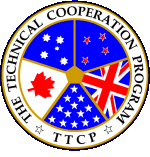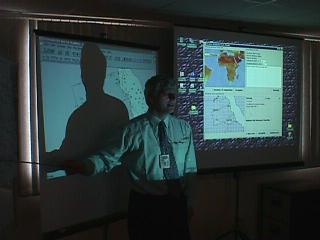



CoAX - Coalition Agents eXperiment
Report on CoAX 9-month demonstration at TTCP meeting on 21-Sep-00 at DERA, Malvern, UK.

Other Images: Image 5, Image 7, Image 17




CoAX - Coalition Agents eXperiment

Like any other military operations, Coalitions need reliable and robust software to support rapid creation, execution and maintenance of campaign plans and to ensure that Commanders have the ‘command agility’ to employ their forces flexibly. Since today's Coalition partners bring a variety of software systems and tools to the Coalition, there is a need to make these systems operate together, so that information provision can be shared amongst the systems, and to ensure that (for example) the information used in the Logistics Plan created by one system does not conflict with that in use in the Air Operations Plan created by another. However, in addressing this requirement for interoperability, it is also crucial to address issues of security of data, control over semi-trusted software from other Coalition partners, and robustness of the resulting system (e.g. the ability to withstand denial-of-service attacks). CoAX aims to show that the agent-based computing paradigm offers a promising new approach to dealing with such issues.
Software Agents can be viewed as entities acting on behalf of, mediating or supporting the actions of human users and having the ability to autonomously carry out tasks to achieve goals or assist the activities of the users. In the CoAX project the software agents carry out tasks which enable the achievement of interoperability between information systems and infrastructure services brought together in a ‘come-as-you-are’ Coalition. In this situation, the software agents operate ‘in the background’ - though matchmaking, domain management, process management and other agent services - to find, establish and maintain the infrastructure, information and procedural links necessary to achieve and support interoperability in a dynamically changing environment. Dealing effectively with these unpredictable changes - owing, for example, to the destructive activities of opponents or because of systems failing and services being withdrawn - is a typical Coalition problem where software agents can make a significant contribution. Hence, the use of software agents provides robustness, flexibility and additional functionality beyond that provided by the individual Coalition partners.
The CoAX project started on 1st February 2000 and contains 16 partners from the US DARPA Control of Agent-Based Systems (CoABS) and the UK DERA Agents Project. On 21st September 2000, we presented our 9-month demo to an audience of military technical experts at the 5-nation Technical Cooperation program (TTCP) meeting held at DERA Malvern in the UK. This demonstration contained 25 separate software agents grouped into 6 agent "domains" - groupings of agents to which the same security policies apply, an example being the Joint Task Force Headquarters domain. These domains allow the agents to work together without compromising security or authority required for Coalition operations. The interoperability of the agents was made possible using the inter-agent communications services provided by the DARPA CoABS Grid, with the policies enforced by KAoS domain management services. The demonstration also contained two existing military systems (UK Master Battle Planner and US Consolidated Air Mobility Planning System), various information providing agents feeding data to Master Battle Planner, and a Process Panel providing the Joint Task Force Commander with a visualisation of the current state of the Coalition operation. The TTCP-created Binni Coalition scenario is used to demonstrate a specific vignette, requiring separation of hostile forces by the UN.
The current demonstration centres on the Joint Forces Air Component Headquarters, which is using Master Battle Planner (MBP) to create the Air Campaign plan. The information agents feed MBP with data concerning the current state of the theatre of operations. Some of this information is found to be inconsistent, so conflicts are resolved by treating data from the field as being more up-to-date. A publicly available source of weather information is also consulted. The US Consolidated Air Mobility Planning System generates validated Airlift missions using air assets and this is automatically provided to MBP and incorporated in the map display - so that the MBP operator can plan in a way that is compatible with this. The MBP operator starts planning by examining various theatre assets, but starts seeing suspicious inconsistencies. Soon it is realised that local forces that are part of the Coalition have been feeding false information to the agent grid in order to further their own cause. Using the agent control tools, this information feed is cut off and the MBP map automatically updates to show the real theatre situation. The local forces, annoyed by being cut off, launch a denial of service attack on the computational facilities being used by the Coalition for field observations. The guard software that is part of the agent framework detects this automatically, and the malicious agent has its runtime resources greatly reduced, thus neutralizing the attack.
The next stage of the CoAX project will integrate a number of other agent services and systems and extend the scope of the agents used to cover execution aspects as well as planning and information gathering. It is hoped that this can be demonstrated at the TTCP workshop in August 2001. The final demonstration is in mid 2002 and involves a very dynamic scenario of coalition changes and a rapidly developing situation in Binni.
Our hypothesis is that software agents together with agent-based infrastuctures and services provided by the CoABS Grid and KAoS could play a key role in Coalition operations. We think that this technology will provide Coalitions with the ability to bring together and integrate systems quickly to aid in all aspects of Coalition operations, without sacrificing security and control. Our long-term goal is to use this technology in the creation, support and dynamic reconfiguration of "virtual organisations" - with Coalitions being an archetypical and timely example of an area where this technology is vitally needed.
For further information, see http://www.aiai.ed.ac.uk/project/coax/
| Coalition Research Home Page | Binni Scenario Home Page | CoAX Project Home Page |